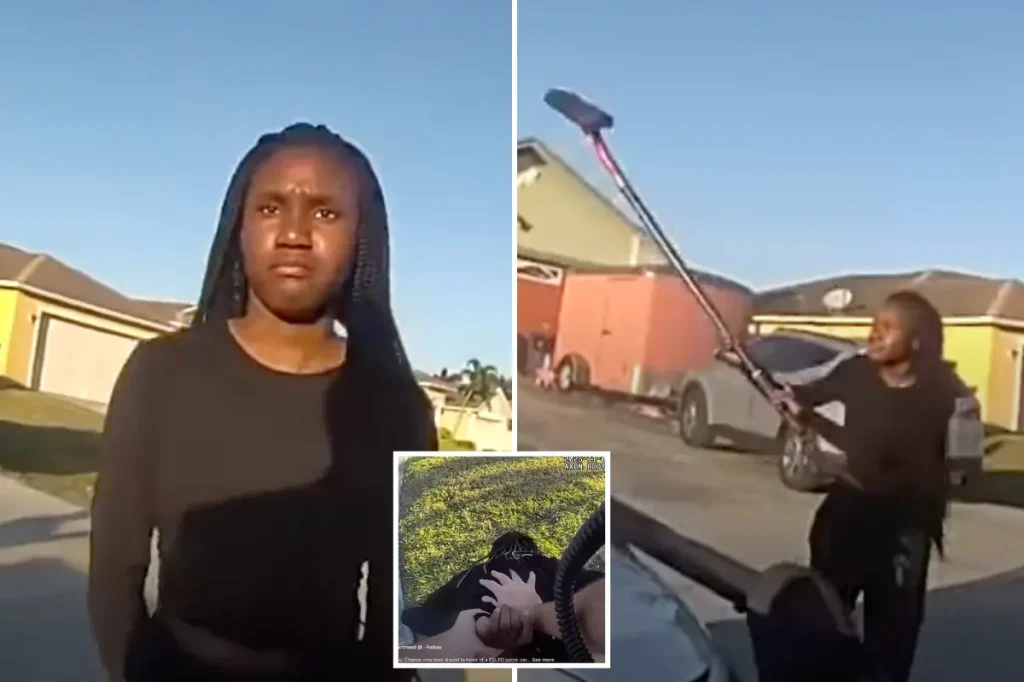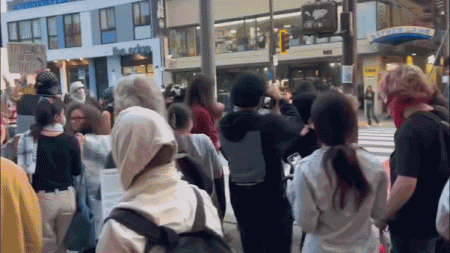Teen’s Shocking Confrontation with Police in Florida Suburb
In a quiet suburban neighborhood of Port St. Lucie, Florida, a disturbing incident unfolded on November 3 when 15-year-old Amy Chance was arrested after attacking a police cruiser with a metal shovel while an officer sat inside. The confrontation, captured on body camera footage released by the Port St. Lucie Police Department, shows the teenager approaching the patrol car in the middle of the street and striking it repeatedly without any apparent provocation. The officer, who had been dispatched to investigate a disturbance at the teen’s family home, was visibly shocked by the unprovoked assault on his vehicle, exclaiming, “Are you kidding me?” before exiting his car to confront the situation. This incident highlights the increasingly complex interactions between law enforcement and young people, where moments of teenage rebellion can quickly escalate into serious criminal charges.
The body camera footage reveals the tense moments that followed, as the officer drew his taser and firmly ordered the teenager to drop the shovel. Facing the pointed taser, the young woman maintained a defiant expression before finally complying with the officer’s command. Even after dropping the weapon, she displayed continued defiance by making an obscene gesture toward the officer and attempting to walk away. The officer responded with measured authority, catching up to her and instructing her to “Get on the f–king ground” – his tone calm but firm as he secured her in handcuffs. Police officials later reported that despite the confrontational beginning, Chance was ultimately “taken into custody without incident,” suggesting that the officer’s training in de-escalation techniques may have prevented the situation from deteriorating further. The teenager’s apparent anger and willingness to damage public property raise questions about what might have triggered such extreme behavior.
The consequences of this impulsive act are significant for the young Florida resident. Chance now faces a felony criminal mischief charge after causing more than $1,200 in damage to the patrol car. In their press release addressing the incident, the Port St. Lucie Police Department made their position clear: “Regardless of age, resorting to intentional damage of people or property in our city will result in an arrest.” This statement reflects the department’s commitment to maintaining community standards regardless of an offender’s youth, while also serving as a warning to other teenagers who might consider similar destructive behavior. What remains unclear from the available information is why police were initially called to Chance’s home and what specifically motivated her to attack the police vehicle with such determination. These unanswered questions leave both the community and observers wondering about the underlying issues that may have contributed to this troubling confrontation.
The Port St. Lucie incident invites reflection on how communities handle behavioral issues among teenagers, especially when those behaviors intersect with law enforcement. While the teenager’s actions were clearly destructive and potentially dangerous, the incident also raises questions about adolescent mental health, family dynamics, and the resources available to families in crisis. Teenagers often act out when experiencing emotional distress, and destructive behavior can sometimes signal deeper problems that require intervention beyond the criminal justice system. Without knowing the specific circumstances that led to the initial police call at Chance’s home, it’s difficult to determine whether this incident represents an isolated moment of poor judgment or part of a pattern of escalating behavior that might benefit from therapeutic intervention alongside legal consequences.
This Florida case stands in stark contrast to a more tragic confrontation that occurred in Anaheim, California, nearly two months earlier. In that September incident, a police officer fatally shot 36-year-old Rudy Anthony Martinez II after he charged at the officer wielding a shovel outside an elementary school. According to reports, the officer had responded to a 911 call about a suspicious man, possibly under the influence, carrying a brick and a shovel. Dashcam footage showed Martinez immediately charging toward the patrol car as it arrived, giving the officer barely enough time to exit his vehicle before the attack began. Despite the officer’s verbal warnings and two initial warning shots, Martinez continued his aggressive approach, ultimately leading to the use of deadly force. Martinez later died at the hospital, a sobering reminder of how quickly confrontations involving weapons can turn fatal.
The juxtaposition of these two shovel-related incidents—one involving a teenager that ended in arrest, the other involving an adult that ended in death—underscores the difficult split-second decisions law enforcement officers must make when confronted with potential threats. In Port St. Lucie, the officer’s measured response to the teenager’s aggression allowed for a non-violent resolution, despite the serious nature of her actions. The officer employed verbal commands, displayed a less-lethal weapon (taser), and used controlled physical restraint to effect the arrest without injury to either party. While Amy Chance now faces serious legal consequences for her actions, the outcome provides an opportunity for intervention, potential rehabilitation, and a second chance. As communities nationwide continue to examine and refine police responses to confrontational situations, especially those involving young people or individuals in crisis, these contrasting incidents serve as powerful case studies in the complex balance between maintaining public safety and recognizing the humanity of those involved, even at their most volatile moments.









